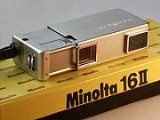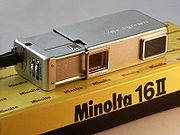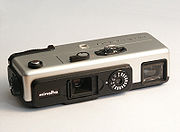
Minolta 16
Encyclopedia


.jpg)
Minolta
Minolta Co., Ltd. was a Japanese worldwide manufacturer of cameras, camera accessories, photocopiers, fax machines, and laser printers. Minolta was founded in Osaka, Japan, in 1928 as . It is perhaps best known for making the first integrated autofocus 35mm SLR camera system...
between 1955 and 1974. The Minolta 16 was the company's first widely successful product, helping to establish its popularity in the world market. The negative size was 10x14 mm for the earlier models, later, a larger format, 12x17 mm was adopted, using single-perforated 16 mm film. It was possible to load your own cassettes, and also develop the film using a special developing tank
Developing tank
A developing tank is a light-tight container used for developing film. A developing tank allows photographic film to be developed in a daylight environment. This is useful because most film is panchromatic and therefore can not be exposed to any light during processing. A developing tank can hold...
with a spiral insert for 16 mm film.
History
The Minolta 16 can be traced back to the Mica Automat built by Konan in 1947. Minolta bought out Konan in the early 1950s and continued producing cameras under the Konan name for several years. The first camera labeled Minolta 16 rather than Konan 16 was the Minolta 16 Automat of 1955. The Minolta 16 used a newly designed filmPhotographic film
Photographic film is a sheet of plastic coated with an emulsion containing light-sensitive silver halide salts with variable crystal sizes that determine the sensitivity, contrast and resolution of the film...
cassette which was not compatible with the Konan models.
Models
The first Minolta 16 camera was the 16 Automat (1955), which was almost identical to the Konan 16 Automat. It featured a fixed-focus 25mm lensPhotographic lens
A camera lens is an optical lens or assembly of lenses used in conjunction with a camera body and mechanism to make images of objects either on photographic film or on other media capable of storing an image chemically or electronically.While in principle a simple convex lens will suffice, in...
, aperture
Aperture
In optics, an aperture is a hole or an opening through which light travels. More specifically, the aperture of an optical system is the opening that determines the cone angle of a bundle of rays that come to a focus in the image plane. The aperture determines how collimated the admitted rays are,...
s from f/3.5 to f/11, and shutter speed
Shutter speed
In photography, shutter speed is a common term used to discuss exposure time, the effective length of time a camera's shutter is open....
s from 1/50 to 1/200 plus bulb. Film advance was via a Minox
Minox
The Minox is a subminiature camera conceived in 1922 and invented in 1936 by German-Latvian Walter Zapp, which Latvian factory VEF manufactured from 1937 to 1943. After World War II, the camera was redesigned and production resumed in Germany in 1948. Originally envisioned as a luxury item, it...
-style push-pull housing.
The 16 was the second Minolta 16 model, introduced in 1957. Basically a more streamlined Automat, it was modified to allow for slip-on filters and close-up lenses and had fewer shutter speeds. It was available in six colors in addition to the standard chrome
Chrome plating
Chrome plating, often referred to simply as chrome, is a technique of electroplating a thin layer of chromium onto a metal object. The chromed layer can be decorative, provide corrosion resistance, ease cleaning procedures, or increase surface hardness.-Process:A component to be chrome plated will...
. This was followed three years later by the 16 II, which appeared identical to the 16 but featured an improved lens and expanded shutter speed and aperture ranges. There was also a version of the 16 II with a built-in transistor radio
Transistor radio
A transistor radio is a small portable radio receiver using transistor-based circuitry. Following their development in 1954 they became the most popular electronic communication device in history, with billions manufactured during the 1960s and 1970s...
, which was sold as the Sonocon 16 MB-ZA starting in 1962.
A more inexpensive model, the 16 P, came out in 1960. It had a rigid body, single shutter speed, and simplified exposure settings that made it easy to use and kept costs down. The 16 Ps of 1965 was the same camera with an additional shutter speed added.
The 16 EE, introduced in 1962, featured a built-in selenium
Selenium
Selenium is a chemical element with atomic number 34, chemical symbol Se, and an atomic mass of 78.96. It is a nonmetal, whose properties are intermediate between those of adjacent chalcogen elements sulfur and tellurium...
light meter
Light meter
A light meter is a device used to measure the amount of light. In photography, a light meter is often used to determine the proper exposure for a photograph...
and shutter-priority automatic exposure. In terms of other features (lens, aperture range, etc.) it was basically similar to the 16 II, though it was larger, had a rigid plastic body, and offered no manual settings. It was replaced in 1963 by the 16 EE2, which used a CdS
Cadmium sulfide
Cadmium sulfide is the inorganic compound with the formula CdS. Cadmium sulfide is a yellow solid. It occurs in nature with two different crystal structures as the rare minerals greenockite and hawleyite, but is more prevalent as an impurity substituent in the similarly structured zinc ores...
cell instead of a selenium meter.
As its 16mm cameras had been growing increasingly large through the addition of more features, Minolta introduced a new and much smaller model, the 16 MG, in 1966. It lacked automatic exposure, but included a light meter and match-needle that were almost as easy to use and offered the added bonus of manual exposure control. The aperture and shutter speed were set at the same time using a single "exposure" dial. The meter was a selenium unit, which did not require a battery
Battery (electricity)
An electrical battery is one or more electrochemical cells that convert stored chemical energy into electrical energy. Since the invention of the first battery in 1800 by Alessandro Volta and especially since the technically improved Daniell cell in 1836, batteries have become a common power...
and hence allowed the camera to be made smaller. The 16 MGS of 1970 was similar but used single-perforated film, which allowed the negative size to be increased and picture quality improved.
The last Minolta 16 was the 16 QT, which was produced from 1972 to 1974. It was a simplified version of the MGS, designed to compete with the new 110
110 film
110 is a cartridge-based film format used in still photography. It was introduced by Kodak in 1972. 110 is a miniaturised version of Kodak's earlier 126 film format. Each frame is , with one registration hole....
format. The QT had a 23mm lens, apertures from f/3.5 to f/22 and two shutter speeds, 1/30 and 1/250. It also offered manual focusing, a departure from previous models.

